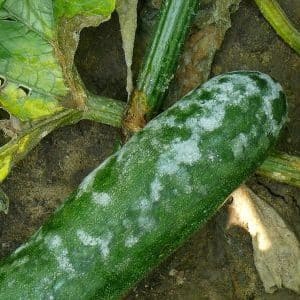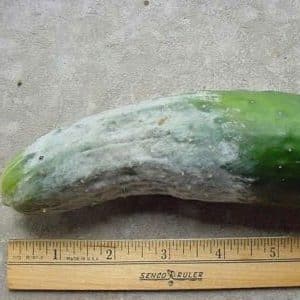How to deal with late blight on cucumbers: treatment regimens
Country crops require care and are sensitive to diseases. Fungi, bacteria, pests attack day after day.
It is not surprising that sometimes one gives up in the fight against all kinds of diseases. Trying to protect the harvest, summer residents use different methods - chemical, biological, folk. But there are diseases that are very difficult to cope with. For example, late blight. We'll tell you what late blight is, why it appears on cucumbers and how to fight it, and photos will help you better understand the problem.
What is late blight

A plant disease, the name of which is translated from ancient Greek as “destroying,” “destroying,” “disastrous,” is late blight.
Phytophthora is a genus of fungi that infects plants and causes disease. There are about 100 species of late blight mushrooms.
It reproduces by zoospores, which tolerate wintering well in the ground, are cold-resistant, and love warmth and moisture. If the disease is not detected at the initial stage, it is difficult to cure. In case of deep damage, a radical method is used - they completely get rid of the plants.
Reasons for the appearance of late blight on cucumbers in greenhouses and open ground
Most often, late blight appears in greenhouses and greenhouses, but this problem is not uncommon in open ground. By observing the rules of alternating planting, the proximity of crops and complete cleaning, they achieve the elimination of late blight on their site.
There are many reasons for the occurrence of fungus, mainly air humidity of more than 75% and ambient temperature +15...+20°C.
Other reasons:
- open ground is characterized by sharp changes in warm daytime and cold nighttime air temperatures;
- frequent and abundant watering of cucumbers contributes to flooding of the soil under the plants;
- high ambient humidity at the same time low air temperature;
- dense planting of cucumber bushes in a greenhouse;
- an incorrectly selected planting site that receives little sun;
- exceeding the permissible lime content in the soil;
- the seed material was not disinfected before sowing;
- if the proximity of crops on the site is disturbed, the infection enters the cucumber beds from the outside;
- incorrect or insufficient plant nutrition, poor soil and, as a consequence, weakness of plants in resisting diseases;
- insufficient ventilation of greenhouses;
- crop residues or tops are not removed for the winter;
- diseased bushes are removed, but not destroyed, which is why the fungus from the compost pit gets back into the beds;
- on open ground, the wind causes fungal microspores to spread throughout the area, so fences or alternation with beds with high tops are necessary;
- Infected bushes were not removed immediately after the disease was detected, and the disease was allowed to transfer from one plant to another.
Signs of late blight
It’s easy to miss a disease. It begins to appear as small brownish-brown spots on the leaves, as in the photo.

If the leaf is turned over, a white cobweb is visible on the underside, barely perceptible to the eye. In the next stage of damage, the leaves begin to curl, turn yellow and fall off.
The absence of ovaries also signals the development of late blight.If fruits are present, soft brown spots form on them, similar to rotting areas. Sometimes, when the disease is advanced, there is a persistent smell of rot.
What is the danger
Late blight itself is not dangerous to humans. You can safely eat fruits affected by late blight. However, no one wants to eat rotten cucumbers and other vegetables. In addition to their unattractive appearance, they also have a corresponding smell. Cucumbers from an already cured bush also look unappetizing. They are unevenly colored and have bumps.
The danger lies in the survivability of this type of fungus: it is not afraid of cold and heat. Once faced with this disease, summer residents then try for years to remove it from the site.
The disease affects cucumbers, tomatoes, eggplants, and potatoes. Affected plants do not bear fruit: tomatoes do not turn red, cucumbers do not set, potatoes lose their tops and do not form tubers. The result is a meager harvest or its complete absence.
Methods of control, treatment regimens and recipes
Late blight on cucumbers can be treated in the initial stage of the disease. The more serious the stage of infection, the less chance of cure. We will tell you in more detail how to fight the disease in a greenhouse and open ground.
Chemicals

In specialized stores for summer residents there are many chemicals to combat late blight. But they should be used with caution and if it is impossible to fight with milder means. After use, do not eat the fruits for a month to avoid poisoning.
The most effective means:
- "HOM" – a fungicidal drug. Refers to contact pesticides of inorganic origin. Used for spraying.To do this, 40 g of the drug is diluted in 100 ml of water, and then, with constant stirring, the water is added to 10 liters.
- "Oxyhom" (copper chloride + oxadixil) – contact-systemic fungicide against late blight. Dilute 1 packet (4 g) per 2 liters of water. Plants are sprayed as necessary up to three times with an interval of 10-14 days.
Biological methods
Biological drugs have a milder effect on the environment and humans. However, they are not as active against fungi.
Treatment is carried out in the initial stages of the disease:
- «Fitosporin-M" - biofungicide in the form of a dark brown paste, liquid or powder. Powder or paste is used in gardening. For spraying, dilute 10 g of powder in 5 liters of water or 3 tsp. pasta in 10 liters of water.
- Copper sulfate. Helps well when spraying. 2 tbsp is enough. l. for 10 liters of warm water.
Folk remedies
If you manage to identify the first signs of late blight, folk methods can also cope with the onset of the disease.
They are completely safe:
- Yeast. 100 g of yeast are diluted in 10 liters of warm water and the affected plants are watered with the resulting solution.
- Garlic and potassium permanganate. Grind 100 g of garlic into a pulp, pour a glass of water and leave to brew for a day. Afterwards, the tincture is diluted in 10 liters of water and 1 g of potassium permanganate is added. Spray the affected plants with the resulting solution every 10 days until fruit sets.
- Wood ash. A week after planting the seedlings, but before the fruit sets, the row spacing is sprinkled with ash between watering plants, leaving time for the ash to absorb excess liquid.
- Milk serum. Dilute the whey from sour milk with water in equal proportions and spray the resulting solution on the seedlings in July.
- Table salt. Use simple, coarse salt, not extra. Dilute 1 glass of salt in 10 liters of water and spray green fruits once a month.
How to treat the soil after infected cucumbers
After harvesting, even with the slightest signs of disease, the soil is disinfected. Fungal spores thrive in the soil for many years.
In the fall, after all the bushes have been removed, they begin to cultivate the soil using any of the following methods:
- the beds are dug up and watered with a solution of copper sulfate;
- 10 g of “Fitosporin” are dissolved in 1 liter of warm water and fertilize the beds;
- water the soil with a solution of potassium permanganate - 2 g of the substance per 10 liters of water;
- dig up soil with wood ash.
The greenhouse itself is not ignored:
- if possible, treat the structure of the greenhouse (greenhouse) with a steam cleaner;
- washed with “Farmayod”;
- remove the top layer of soil in the greenhouse and replace it with a new one;
- sow white mustard and, before flowering, dig up the soil, burying the mustard stems inside the bed.
Is it possible to eat infected cucumbers?
If the appearance allows the fruit to be eaten, it does not pose a danger to humans. However, such cucumbers have an unpresentable appearance and poor taste. This is what discourages them from being used as food.
You should not preserve cucumbers infected with late blight. The banks won't last long.
Prevention
If you follow a few rules, the disease will not appear in your summer cottage:
- alternate planting sites;
- plant varieties that have strong immunity to late blight;
- regularly ventilate the greenhouse;
- do not allow the bed to become waterlogged;
- burn infected bushes and do not use them as compost;
- feed the seedlings with potassium-phosphorus fertilizers;
- disinfect seeds before planting by soaking them in a weak solution of potassium permanganate.
Conclusion
In the fight against late blight, the most important thing is to be on time. Carefully monitor the condition of the leaves and ovaries and, at the slightest suspicion of late blight, proceed with treatment, avoiding the situation from worsening.